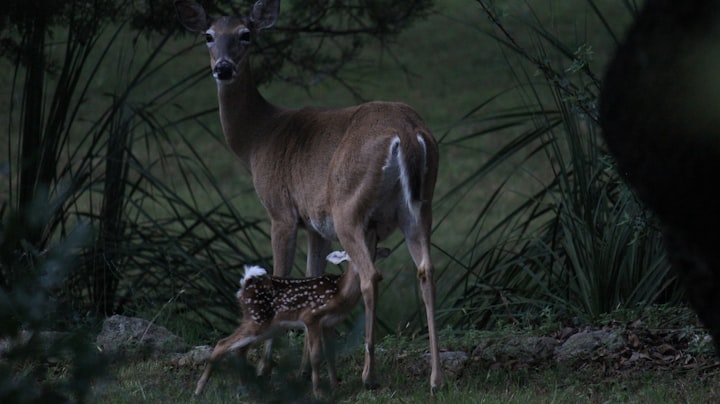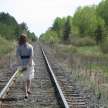A Deer in Winter
A doe with a fawn; a girl with a baby

At first, I just noticed this young doe haunting the same place. She grazed there in broad daylight, tawny body bright against the spring grasses. No doe would stay so long in one place without something to protect…and after several days, I saw him. Stalking carefully through the tall grass behind her was her fawn, balancing effortlessly on his incredibly slender pins. Baby deer can look remarkably like spiders at that age. His dappled coat looked painted on when he was upright, but I knew from experience that it made him invisible when he held very still in the grass.
She was a young deer in her first mating season—or so it seemed by her frame, slightly smaller and more slender than the older doe I usually saw her with. But it wasn’t just her size that made me suspect her youth. It was also the foolish place she had chosen to raise her fawn, a place surely no older and wiser doe would have chosen. She had selected a man-made waterway, dug through the cornfields, that went directly under a major highway, and opened into a little pond on the other side. Her safe little hiding spot was open to the world.
I passed her grassy ditch daily and saw her often. As the fields on either side of it grew up into jungles of corn, I wondered if her chosen nursery wasn’t so foolish after all. Now, she was surrounded by tender corn and an immediate hiding place. Where before I could see her far across the field when she and her baby came out of the ditch to graze, now I just wondered if she was in there somewhere, watching us fly by her on the highway.
***
Similar brown eyes followed me from the front row of my classroom every day. She was in eighth grade and expecting a baby herself. She already didn’t fit in the one-size-fits-all desks. We had hunted all over the school for a special desk just for her—as if she didn’t already feel like she suddenly stood out in all the wrong ways. Everyone else was planning for the Fall Formal; she was adjusting to nursing bras. She was still growing herself and was experiencing complications—I would often write exceptions on her homework, as other teachers did, too.
She was out for a week when her baby was born. Adults get weeks off; as a student, she was afraid she would get too far behind. The plan was that her grandmother would bring the baby to school once a day. As her homeroom teacher, I set up lunch for her in my room so that she could nurse her baby in private with a locked door. I tried to take the chance to get to know her personally, too. Her change from fifteen-year-old-student to parent had suddenly distanced her from her friends. Something had changed, even if they couldn’t define it. It seemed to work best when they all sort of pretended that there was no baby in the picture.
Somehow, in my mind, the young doe and my student became symbolic of each other. When I saw one, I thought of the other. While the fields were still young, I had learned the doe’s habits. Now that her baby was a little older, she had rejoined her small herd, and she ran with three other doe and a buck with five points growing on his new rack. Sometimes I saw her on the other side of the road—but every time I did, her fawn wasn’t with her. She had left her baby at home, likely curled up tightly in the waterway, waiting for his mother. She was doing better than I had expected. Perhaps this young doe was still in a school of sorts, too.
***
Summer lengthened fast. In Michigan, summers are short and growing seasons are shorter. Both the plants and the animals have to mature fast. The fawn was growing quickly, and when I saw him, I noted that he was fat and healthy. The lines of his body weren’t quite as willowy as hers—he must have taken after his father, the five-point. But he hadn’t yet outgrown his spots.
My student was still nursing her baby at lunch and slipping out of class in the afternoons to pump. She looked exhausted but determined. Her homework was done on time, and even when I gave her extensions or exceptions, she did it on time anyway. I had learned about her situation; she lived with her grandmother because it was her mother’s boyfriend who had gotten her into this state of affairs in the first place. He was in jail, now, but his jail time was easy compared to the long road of trauma, lost childhood, and early motherhood she had to walk. But I had high hopes for her.
It was on a sunny morning in the mid-autumn after an early freeze and I was approaching the stretch of road where I usually saw the doe. The pond, I noticed, had a thin sheaf of ice over it. I kept my eyes peeled there—I didn’t care for any long-legged surprises on the blacktop. I noticed snaky black streaks on the road where someone had burned rubber trying to stop fast. Then in a blur, as I passed, I saw the tawny coat, dappled with white, huddled in the grass on the side of the road.
I didn’t need to go back and check. No healthy deer lies on his side, legs splayed, so close to the road, and only immature deer still have their spots. She had tried to cross with him. She had to do it sometime. She had to teach him one day how to get across the road to the pond, to the alfalfa field, to the next grazing ground. All the best efforts of a young mother had failed.
I fairly flew to school. I just knew something was wrong. Before I could even ask about her, the principal found me. Her grandmother’s car had spun out on the ice on the way to school—something about a deer in the road. The baby had been with them. All three of them were in the hospital. I spent the day with my head in a whirl. At some point, I gave up trying to teach and gave my students time to work on their projects and read their favorite books. On my drive home, I stopped along the road where the fawn lay.
Unable to bear the idea of seeing him lie there day after day, I rolled his small body down the ditch and watched it slide quietly into the pond, barely making a hole in the thin ice. I looked up to see the doe watching me. She must have been close by all day. Only after he disappeared under the water did she turn and melt into the corn.
I learned the next day that my student and her grandmother were fine, having been discharged early in the day. But the baby was being kept a few days for observation, and his young mother flat out refused to leave the hospital. They couldn’t send her away. I stopped by after school with a hot meal that wasn’t hospital cafeteria food. As I sat with her, she suddenly looked older to me. It wasn’t just the dark circles under her eyes, but it was the maturity that her own mother and mother’s boyfriend didn’t have—or a great many adults I knew myself.
In a few days, her baby was discharged with full health and she came back to classes, tired, but as determined as ever. She would be moving on to high school the next year, and I knew this would be the last year I would ever have any interaction with her, so I tried to make the most of it. But still, I worried about her. The following Spring, I was driving to school when I saw what was surely the same doe. She looked older now, and was warier, not standing in the open waterway but at the edge of the field near the woods. The way she held her head made it clear that a hard winter had taught her much. But as I drove past, I saw a little form behind her—a fawn. I stopped the car and we stared at one another, fawn peering from between her legs. I like to think she remembered me. Then she turned and faded into woods at the edge of the field.
Everything was going to be just fine.
About the Creator
Lydia Stewart
Lydia is a freelance copywriter and playwright, watercolorist and gardener living in Michigan. She loves to collaborate with writer friends, one of whom she married. Her inspirations come from all of these interests and relationships.






Comments
There are no comments for this story
Be the first to respond and start the conversation.